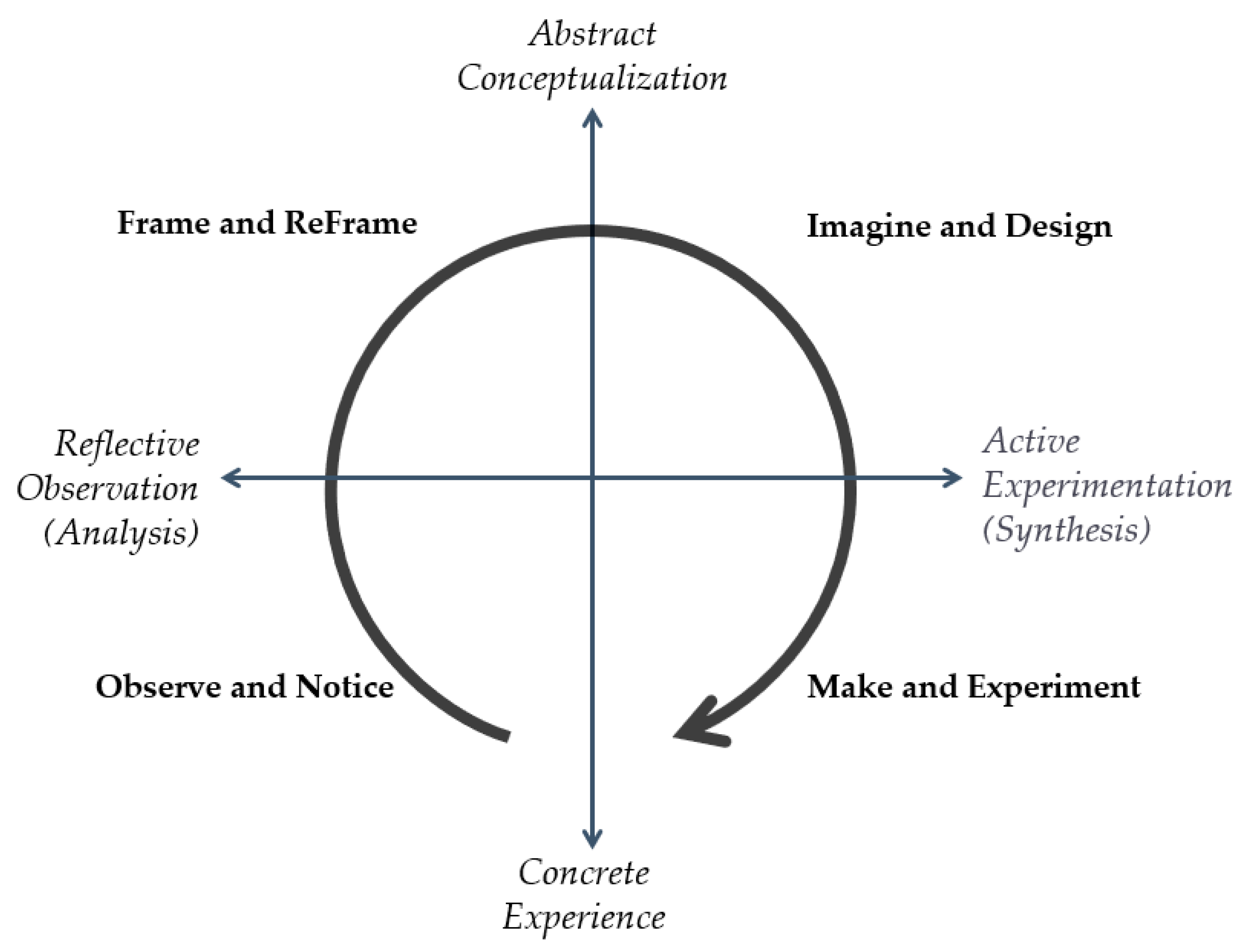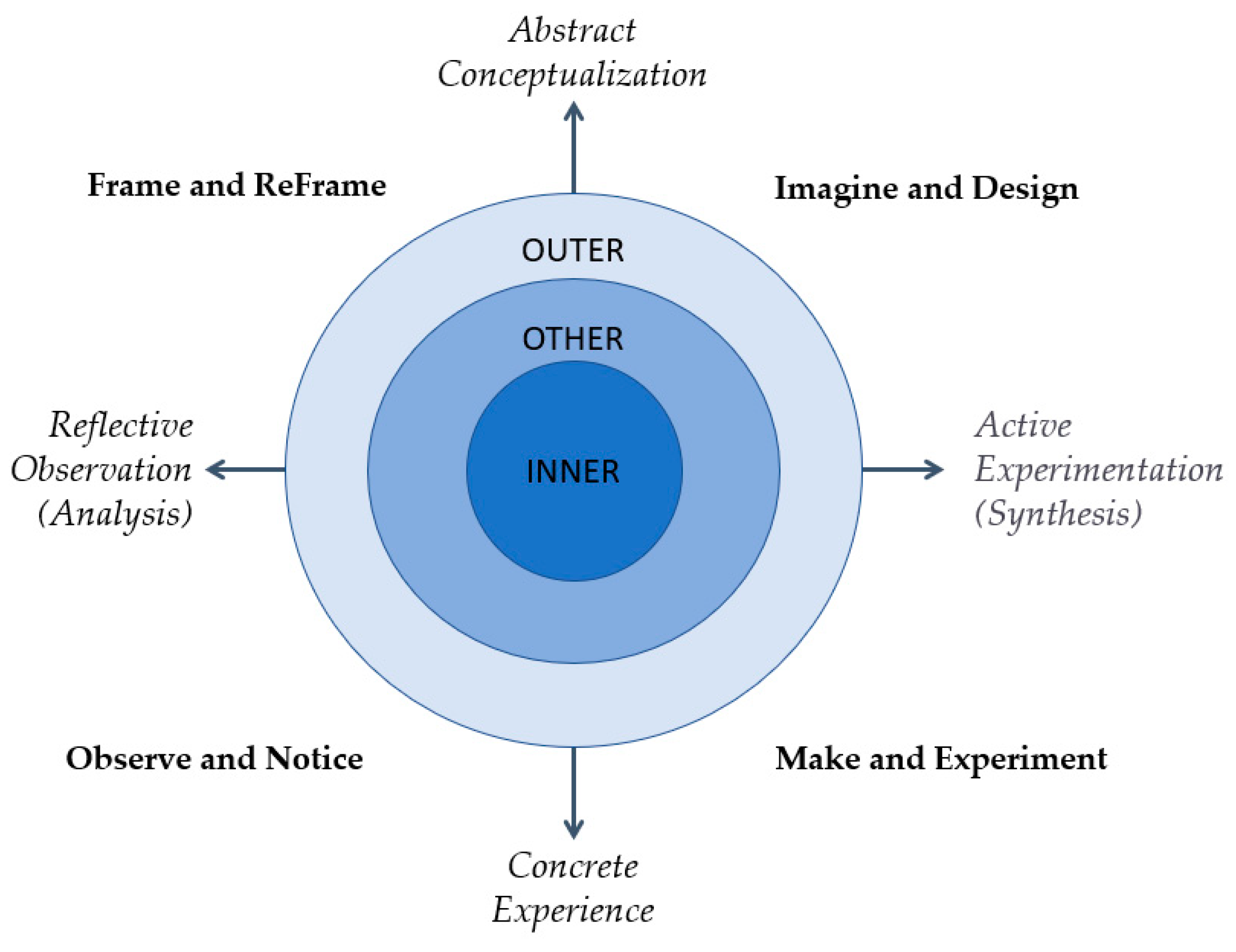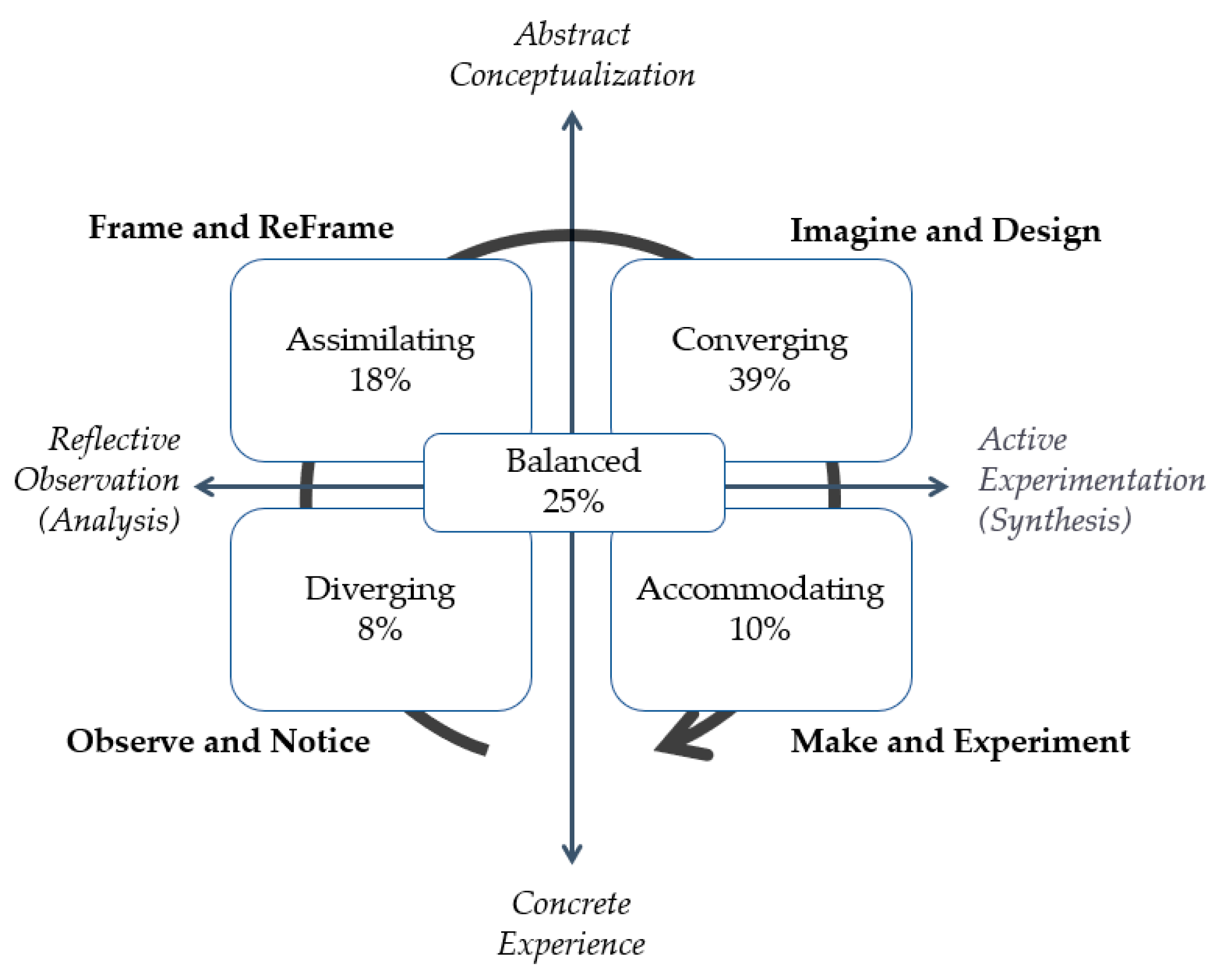Collaborative Innovation: Exploring the Intersections among Theater, Art and Business in the Classroom
Abstract
:1. Introduction
2. Collaborative Innovation Course: Background and Frameworks
2.1. Collaborative Innovation Course Description
2.2. Frameworks Used to Integrate the Disciplines
2.2.1. Innovation Cycle
2.2.2. Inner, Other, Outer
3. Student Reflections on Learning from Course
3.1. Data Sources and Analysis Methods
Reflection assignment: This assignment provides you an opportunity to focus on and root into your own journey through Collaborative Innovation this semester. Write a reflection on your journey starting with reviews of your prior work: Look at your earliest writings and responses to initial exercises, particularly your first discussion of who you are and what you wanted to get out of the class. Then re-read your “coming from where I’m from” writings. Write a paragraph in response to the prompt: “on this part of my journey, I learned this about myself…”. Then add a one-paragraph assessment of your experience with your classmates in the teams you worked with this term reflecting on: the pairings, groupings and final group, the interactions, transactions and conversations, what you learned most about yourself from others, what you learned most about others. Close with one sentence describing what the word innovation means to you now that you have taken this class.
3.2. Internalizing Inner–Other–Outer
3.3. Teaming at the Heart
3.4. Transformation Through Iteration
3.5. Experience-Based Learning to Become
4. Conclusions
Author Contributions
Funding
Acknowledgments
Conflicts of Interest
References
- Weick, K.E. Drop your tools: On reconfiguring management education. J. Manag. Educ. 2007, 31, 5–16. [Google Scholar] [CrossRef]
- Chew, E.B.; Mcinnis-Bowers, C. Blending Liberal Art and Business Education. Lib. Educ. 2004, 90, 1–7. [Google Scholar]
- Adler, N.J. The arts and leadership: Now that we can do anything, what will we do? Adv. Apprec. Inq. 2007, 2, 207–232. [Google Scholar]
- Bobko, P.; Tejeda, M.J. Liberal Arts and Management Education: Reemphasizing the Link for the 21st Century. J. Bus. Educ. 2000, 1, 1–10. [Google Scholar]
- Schiuma, G. The Value of Arts for Business; Cambridge University Press: Cambridge, UK, 2011. [Google Scholar]
- Anderson-Inman, L. Thinking between the lines: Literacy and learning in a connected world. Horizon 2009, 17, 122–141. [Google Scholar] [CrossRef]
- Kramer, J.; Agogino, A.M.; Beckman, S.L.; Castaños, C.; Roschuni, C.; Yang, M. Design Practitioners’ Perspectives on Methods for Ideation and Prototyping. Int. J. Eng. Educ. 2016, 32, 1428–1437. [Google Scholar]
- Byrnes, W.J. Management and the Arts; Elsevier, Inc.: Burlington, MA, USA, 2009. [Google Scholar]
- McNicholas, B. Arts, Culture and Business: A Relationship Transformation, a Nascent Field. Int. J. Arts Manag. 2004, 7, 57–68. [Google Scholar]
- Nissley, N. Arts-based learning at work: Economic downturns, innovation upturns, and the eminent practicality of arts in business. J. Bus. Strategy 2010, 31, 8–20. [Google Scholar] [CrossRef]
- Snyder, J.; Heckman, R.; Scialdone, M.J. Information studios: Integrating arts-based learning into the education of information professionals. J. Am. Soc. Inf. Sci. Technol. 2009, 60, 1923–1932. [Google Scholar] [CrossRef]
- Glen, R.; Suciu, C.; Baughn, C.C.; Anson, R. Teaching design thinking in business schools. Int. J. Manag. Educ. 2015, 13, 182–192. [Google Scholar] [CrossRef]
- Brynjolfsson, E.; Mcafee, A. The Second Machine Age; Milken Institute Review: Santa Monica, CA, USA, 2014. [Google Scholar]
- Dall’alba, G. Learning Professional Ways of Being: Ambiguities of becoming. Educ. Philos. Theory 2009, 41, 34–45. [Google Scholar] [CrossRef] [Green Version]
- Harris, A.; Davis, S.; Snepvangaers, K.; De Bruin, L. Creative Formats, Creative Futures. Depart. Qual. Res. 2017, 6, 48–61. [Google Scholar] [CrossRef]
- Kolmos, A.; De Graaff, E. Problem-Based and Project-Based Learning in Engineering Education: Merging Models. In Cambridge Handbook of Engineering Education Research; Johri, A., Olds, M., Eds.; Cambridge University Press: Cambridge, UK, 2014; pp. 141–161. [Google Scholar]
- Wiek, A.; Brundiers, K.; Van Der Leeuw, S. Integrating problem- and project-based learning into sustainability programs. Int. J. Sustain. High. Educ. 2014, 15, 431–449. [Google Scholar] [CrossRef]
- Page, S.E. Making the Difference: Applying a Logic of Diversity. Acad. Manag. Perspect. 2007, 21, 6–20. [Google Scholar] [CrossRef] [Green Version]
- Helguera, P. Education for Socially Engaged Art, 1st ed.; Jorge Pinto Books: New York, NY, USA, 2011. [Google Scholar]
- Kolb, D.A. Experiential learning: Experience as the source of learning and development. J. Organ. Behav. 1984, 8, 359–360. [Google Scholar]
- Owen, C. Design Thinking: Notes on Its Nature and Use. Des. Res. Q. 2006, 1, 16–27. [Google Scholar]
- Beckman, S.L.; Barry, M. Innovation as a Learning Process: Embedding Design Thinking. Calif. Manag. Rev. 2007, 50, 25–56. [Google Scholar] [CrossRef]
- Kolb, A.Y. The Kolb Learning Style Inventory—Version 3.1 2005 Technical Specifications; Hay Resource Direct: Boston, MA, USA, 2005. [Google Scholar]
- Klein, G.; Moon, B. Making sense of sensemaking 1: Alternative perspectives. IEEE Intell. Syst. 2006, 21, 70–73. [Google Scholar] [CrossRef]
- De Jaegher, H.; Di Paolo, E. Participatory sense-making: An enactive approach to social cognition. Phenomenol. Cognit. Sci. 2007, 6, 485–507. [Google Scholar] [CrossRef]
- Cole, A.L.; Knowles, J.G. Arts-Informed Research. In Handbook of the Arts in Qualitative Research: Perspectives, Methodologies, Examples and Issues; Sage Publications: Thousand Oaks, CA, USA, 2008. [Google Scholar]
- Mayfield, M. Thinking for Yourself, 1st ed.; Thomson Wadsworth: Boston, MA, USA, 2007. [Google Scholar]
- Spatz, B. What a Body Can Do: Technique as Knowledge, Practice as Research; Routledge: London, UK, 2015. [Google Scholar]
- Taylor, S.S.; Ladkin, D. Understanding arts-based methods in managerial development. Acad. Manag. Learn. Educ. 2009, 8, 55–69. [Google Scholar] [CrossRef]
- Oliver, D.; Heracleous, L.T.; Jacobs, C.D. Balancing divergence and convergence: Stimulating creativity through hybrid thinking. In Handbook of Management and Creativity; Edward Elgar Publishing: Cheltenham, UK, 2014; pp. 325–345. [Google Scholar]
- Thornquist, C. Artistic Development in [Fashion] Design; The Textile Research Centre, CTF: Boras, Sweden, 2010. [Google Scholar]
- Berglin, L.; Cederwall, S.L.; Hallnäs, L.; Jönsson, B.; Kvaal, A.K.; Lundstedt, L.; Nordström, M.; Peterson, B.; Thornquist, C. Interaction Design Methods in Fashion Design Teaching. Available online: https://gupea.ub.gu.se/bitstream/2077/18072/1/gupea_2077_18072_1.pdf (accessed on 25 October 2018).
- Schrage, M. Embrace Your Ignorance. MIT Sloan Manag. Rev. 2015, 56, 95. [Google Scholar]
- Buxton, B. Sketching User Experiences: Getting the Design Right and the Right Design; Morgan Kaufmann: Burlington, MA, USA, 2007. [Google Scholar]
- Thomke, S.H. Managing Experimentation in the Design of New Products. Manag. Sci. 1998, 44, 743–762. [Google Scholar] [CrossRef]
- Cope, J. Entrepreneurial learning from failure: An interpretative phenomenological analysis. J. Bus. Ventur. 2011, 26, 604–623. [Google Scholar] [CrossRef] [Green Version]
- Hirst, L. The Art of Critical Making; John Wiley & Sons: Hoboken, NJ, USA, 2013. [Google Scholar]
- Goleman, D. The Focused Leader. Harv. Bus. Rev. 2013, 91, 50–60. [Google Scholar]
- Colby, A.; Ehrlich, T.; Sullivan, W.M.; Dolle, J.R. Rethinking Undergraduate Business Education; Jossey-Bass: San Francisco, CA, USA, 2011. [Google Scholar]
- Paris, D.C. Business and the Liberal Arts: Integrating Professional and Liberal Education. Available online: https://eric.ed.gov/?id=ED499104 (accessed on 25 October 2018).
- Battarbee, K.; Suri, J.F.; Howard, S.G. Empathy on the Edge: Scaling and Sustaining a Human-Centered Approach in the Evolving Practice of Design; IDEO: Palo Alto, CA, USA, 2014; pp. 1–14. [Google Scholar]
- Constable, G. Talking to Humans: Success Starts with Understanding your Customers; Amazon Digital Services: Seattle, WA, USA, 2014. [Google Scholar]
- Portigal, S. Interviewing Users: How to Uncover Compelling Insights; Rosenfield Media: New York, NY, USA, 2013. [Google Scholar]
- Edmondson, A. Teaming: How Organizaons Learn, Innovate, and Compete in the Knowledge Economy; Jossey-Bass: San Francisco, CA, USA, 2012. [Google Scholar]
- McChrystal, S.; Collins, T.; Silverman, D.; Fussell, C. Team of Teams: New Rules of Engagement for a Complex World; Portfolio: New York, NY, USA, 2015. [Google Scholar]
- Sterman, J.D. Business Dynamics: Systems Thinking and Modeling for a Complex World; McGraw-Hill Education: New York, NY, USA, 2000. [Google Scholar]
- Meadows, D.H. Thinking in Systems: A Primer; Chelsea Green Publishing: White River Junction, VT, USA, 2008; Volume 53. [Google Scholar]
- Yin, R.K. Qualitative Research from Start to Finish; Guilford Publications: New York, NY, USA, 2015. [Google Scholar]
- Morse, J.M.; Barrett, M.; Mayan, M.; Olson, K.; Spiers, J. Verification Strategies for Establishing Reliability and Validity in Qualitative Research. Int. J. Qual. Methods 2002, 1, 13–22. [Google Scholar] [CrossRef]
- Edmondson, A.C.; Harvey, J.F. Cross-boundary teaming for innovation: Integrating research on teams and knowledge in organizations. Hum. Resour. Manag. Rev. 2016, 28, 347–360. [Google Scholar] [CrossRef]
- Lau, K.; Agogino, A.; Beckman, S. Global Characterizations of Learning Styles Among Students. In Proceedings of the ASEE for Engineering Education International Forum, Atlanta, GA, USA, 22 June 2013. [Google Scholar]
- Ely, R.J.; Thomas, D.A. Cultural Diversity at Work: The Effects of Diversity Perspectives on Work Group Processes and Outcomes. Adm. Sci. Q. 2001, 46, 229–273. [Google Scholar] [CrossRef]



| Major Category | Number of Students | Percent of Students |
|---|---|---|
| Art, Practice, History | 19 | 13% |
| Business | 18 | 12% |
| Theater, Dance Performance | 18 | 12% |
| Cognitive Science | 13 | 9% |
| Computer Science | 12 | 8% |
| Engineering | 10 | 7% |
| Media Studies (Film, Communications) | 8 | 5% |
| Economics | 7 | 5% |
| Political Economy/Science | 7 | 5% |
| Architecture | 6 | 4% |
| Environmental Studies | 5 | 3% |
| Sociology | 5 | 3% |
| Science (Chemistry, Biology) | 5 | 3% |
| Other (16 majors represented) | 18 | 12% |
| TOTAL DECLARED MAJORS | 151 | 100% |
© 2018 by the authors. Licensee MDPI, Basel, Switzerland. This article is an open access article distributed under the terms and conditions of the Creative Commons Attribution (CC BY) license (http://creativecommons.org/licenses/by/4.0/).
Share and Cite
Beckman, S.; Scott, S.J.; Wymore, L. Collaborative Innovation: Exploring the Intersections among Theater, Art and Business in the Classroom. J. Open Innov. Technol. Mark. Complex. 2018, 4, 52. https://doi.org/10.3390/joitmc4040052
Beckman S, Scott SJ, Wymore L. Collaborative Innovation: Exploring the Intersections among Theater, Art and Business in the Classroom. Journal of Open Innovation: Technology, Market, and Complexity. 2018; 4(4):52. https://doi.org/10.3390/joitmc4040052
Chicago/Turabian StyleBeckman, Sara, Stacy Jo Scott, and Lisa Wymore. 2018. "Collaborative Innovation: Exploring the Intersections among Theater, Art and Business in the Classroom" Journal of Open Innovation: Technology, Market, and Complexity 4, no. 4: 52. https://doi.org/10.3390/joitmc4040052
APA StyleBeckman, S., Scott, S. J., & Wymore, L. (2018). Collaborative Innovation: Exploring the Intersections among Theater, Art and Business in the Classroom. Journal of Open Innovation: Technology, Market, and Complexity, 4(4), 52. https://doi.org/10.3390/joitmc4040052




